Posted by Dave Bull at 10:40 AM, March 11, 2010
Unlike the previous Hanga Treasure Chest series, the prints in this one will have a 'unified' appearance. In the old days, whenever prints were issued in sets, it was common to include a 'cartouche' as part of the design, in which both the series title, and the title of each particular print, would be written. And so it will be with this series.
But with a slight twist. As has become obvious by now - from the images of the blocks that I have shown - I am making these prints in pairs. Not two copies of the same image side-by-side (which was frequently done whenever a high volume of prints was needed), but two different images from the series. Numbers 1 and 2 are being made together, then 3 and 4 ... etc. etc.
You have already seen the block for the decorative border pattern, and could clearly see the way that the two prints are arranged on the block. The next one to be carved will be for the border outlines, the cartouches, and the series title. But because the print title will change each time, it cannot be included on this block, but will be carved together with one of the blocks for each particular design. The cartouche block with the series title, will leave a blank space where the print title will appear later.
I made my first dummy images (the one for the pamphlet, etc.) using computer text output for the titles, but for the real prints, I am using real calligraphy. Long-time collector Mrs. Tauchi (who appeared in this newsletter story) has come through again with some beautiful work.
It is extremely delicate calligraphy, and contains lines far too thin to be carved on 'normal' cherry wood. I need something harder, and the standard material for this is tsuge (boxwood), the same wood used for traditional wooden combs.
This though, brings another problem. In the old days, the carver would look at a design, figure out what parts of it (if any) required boxwood, and then place an order with his block supplier for a plank with inlays at the appropriate place(s), all planed perfectly smooth, ready to go. But the last traditional block supplier (Shimano Shintaro) died more than 10 years ago, and in any case, he didn't do this kind of work anyway. Each time I have needed boxwood inlays in my blocks, I have had to do them myself.
Let's begin ...
First step is to work out the places where the inserts will go, and dig some holes (I use a router for this). You can now also see something else about the series design concept - each pair will have one print in vertical orientation, and one horizontal.
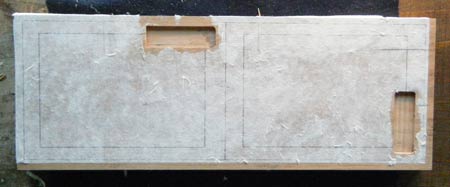
The holes are about 4mm deep, and I will be inlaying slips of boxwood about 5~6 mm thick:
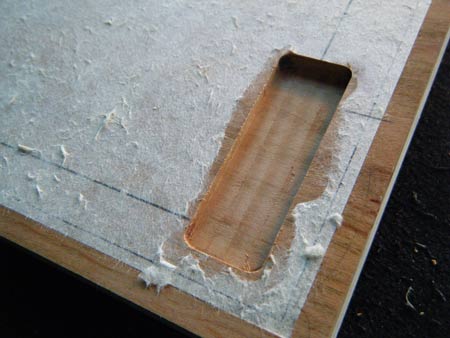
I cut the pieces slightly oversize, and then use a file to slowly bring them down to the correct dimensions, testing constantly as I get close. It's difficult to get them exactly right, because you can't put them into the holes for testing ... (you can never get them out again). (I'll be using the reverse face of this block, so can't drill holes all the way through ...)
The final step is to put a very slight bevel on each edge, so that they just squeeze into their holes snug and firm.
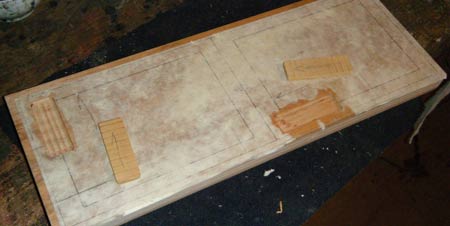
When they are ready, I lightly glue them, tap them into place, and clamp them tightly until they are set.
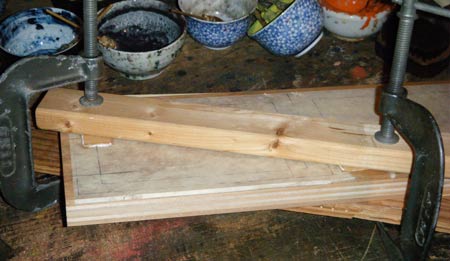
I have no photo of the next step ... I can't do it and shoot at the same time. But it's not complicated; I just plane them down as far as I dare without nicking the main block surface anywhere, then use a light file to bring them down to nearly flush.
For the final step, I don't use sandpaper, as that leaves the surface of the wood 'torn', but take the blade out of the plane, and stand it on end to use as a 'scraper blade'; it pulls off the finest of shavings. For the final few strokes, you let up on the pressure, and nothing much more than 'dust' comes off the surface, leaving a very nice joint:
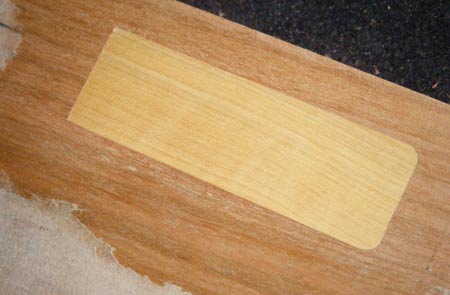
You can see the different piece of wood there clearly of course, but you can't feel it!
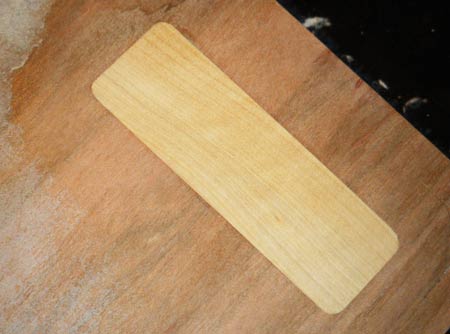
So there we are, ready for Tauchi-san's calligraphy (on delicate gampi paper) to be pasted down and carved.
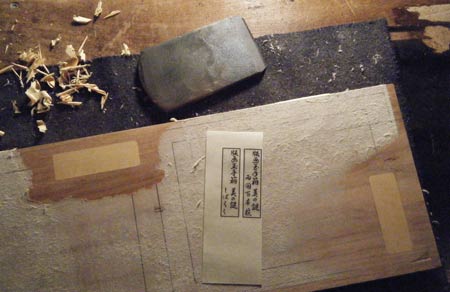
Each time I do this inlaying job, I get a kind of strange feeling about it. Back in the old days (Edo into early Meiji) there were many thousands of men working in the woodblock field, making not just the famous prints we remember, but books, posters, wrapping papers ... anything that needed printing. There were of course dozens of block suppliers providing the wood for all this carving. Not much of the work (in percentage terms) needed these boxwood inlays, but it would still have been a common thing for the suppliers to do. They must have been - of course - very good at it.
That tradition is now totally lost. None of the carvers now working have any experience of cutting boxwood at all, and there is certainly nowhere that they can 'order' a block like this, even if they had the requirement for it.
So we have this bizarre situation where this Canadian guy is sitting here in this little workshop, and is kind of the 'inheritor' to that entire tradition ... all those thousands of terrifically skilled men, making all those famous prints that we now treasure. Their tradition is now still living ... only here.
Me.
I just can't get my head around that.
I don't mean to imply that I am the 'only one left' in the world of traditional carving. That's not true at all. There are maybe a half-dozen people left who can carve at a decent level, and I'm not even the youngest (that honour goes to Koike-san, about whom I wrote more than ten years ago.) But they never get the chance to even attempt this sort of thing, as they never choose their own work, but just sit and wait for whatever publishers send them, and no publisher would think of doing work like this these days.
I was talking to carver Asaka-san (a very fine craftsman) about this a while ago, and he just shook his head in amazement at what I am doing. But would he like to be doing this? There is just no such thought ...
So ... it's just me. Tomorrow morning I will begin carving that lettering, full of pleasure at the feel of the blade slicing that beautifully hard and smooth wood, but also with sadness ... that nobody else also enjoys that pleasure.
Just. Me.

